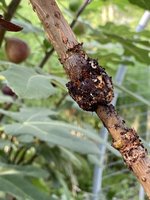Yes, I leave air layers on hardy trees OUTSIDE, all winter. No heat. Yes, if the mother plant normally survives outside, the air layer can be left on the mother plant ALL WINTER, outside. No heat, no contraptions. It is really that simple.
When you do an air layer, first stage is to form callus. The callus has the same winter hardiness at the mother plant's trunks and branches.
Roots will form from the callus, when they form can be in late winter. Often there is a flush of root growth a few weeks before the mother plant leafs out in spring. If you are impatient with air layers, you will miss this opportunity.
Last tip: I have found soil in the air layer to have a much lower success rate to using long fiber sphagnum moss. Sphagnum moss has several advantages. It holds a tremendous amount of water. The best "brands" of sphagnum moss to use are Chilean and New Zealand sourced long fiber sphagnum moss. The reason is that the species of sphagnum from NZ & Chile have a fairly high phenolic content. The phenol serves to slow decomposition and has antibacterial and antifungal properties. Sphagnum moss sourced from Wisconsin has the lowest phenolic content of source species tested. So if you can get Chilean origin moss, that is the best. Commonly sold for use as an orchid potting media. Check Orchids by Hausermann, Elmhurst IL. Their do mail order.
The reason you have isopods, and other pests in your air layer is that you are using "dirt". The fungi and bacteria in your "dirt" is attracting the isopods and other pests. If you need to do air layers in the future, try sphagnum, it will remain pest free much longer than "dirt".


